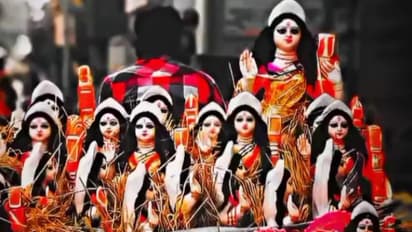Saraswati Puja 2024: Date, time, history and significance of Vasant Panchami

Synopsis
Basant Panchami, heralding spring in Hindu tradition, honors Goddess Saraswati, symbolizing knowledge and creativity. Devotees seek blessings through prayers, wearing yellow attire, and sharing festivities
Basant Panchami, also known as Vasant Panchami or Shri Panchami, holds a significant place in Hindu culture as it marks the onset of spring, typically falling on the fifth day of the Magha month. This auspicious occasion not only celebrates the change in seasons but also serves as a precursor to the festivities of Holi, which commences forty days post-Basant Panchami. In India, mustard flowers bloom during this time, lending the festival its association with the vibrant color yellow.
Central to Basant Panchami celebrations is the reverence of Goddess Saraswati, embodiment of learning, creativity, and music. Devotees pay homage to her on this day, seeking blessings for wisdom and artistic pursuits. The festival is also a time for joyous gatherings with loved ones, marked by feasting and sharing.
ALSO READ: Teddy Day 2024: What, why and when do we celebrate this day
According to Hindu mythology, Basant Panchami holds tales of transformation and renewal. One such legend recounts the story of Kalidasa, who, on the brink of despair, was granted divine intervention by Goddess Saraswati, leading to his enlightenment as a renowned poet. Another narrative involves Lord Kama's intervention in Lord Shiva's meditation, ultimately resulting in Kama's demise and subsequent resurrection as Lord Krishna's son, Pradumna.
The significance of the color yellow on Basant Panchami is multi-faceted. Not only does it symbolize knowledge and intellect, but it also represents the mustard fields that flourish during the spring season. Therefore, yellow attire, traditional foods, and decorations adorn households and temples during the festivities.
The puja rituals on Basant Panchami are centered around Goddess Saraswati, attracting intellectuals, artists, and students seeking her blessings. Devotees visit temples to offer prayers, seeking guidance and inspiration in their pursuits. Yellow flowers and sweets are presented as offerings, accompanied by the recitation of hymns and mantras in honor of the goddess.
Explore the latest Lifestyle News covering fashion, wellness, travel, Food and Recipes, and more. Stay updated with trending Health News, fitness tips, and expert insights to inspire your daily living. Discover personalized lifestyle trends that keep you stylish and informed. Download the Asianet News Official App from the Android Play Store and iPhone App Store for everything that adds value to your everyday life.